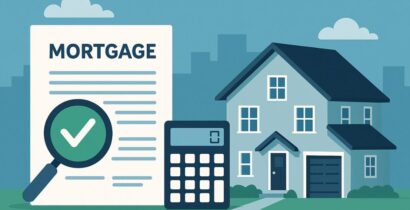Fixed vs. Adjustable-Rate Mortgages: Which One Fits Your Budget?
- August 27, 2025
- Home buying, House, Real Estate
- 9 mins read
Selecting the right mortgage plan can significantly impact your finances and long-term financial goals. Both fixed-rate and adjustable-rate mortgages offer their benefits, based on your objectives, income, and the duration of time that you will be living in your home. Knowing the differences allows you to choose the most suitable one for you.
How Fixed-Rate Mortgage Works?
A fixed-rate mortgage is a home loan in which the interest rate remains constant throughout the duration of the loan. This means your interest monthly payments will remain the same, providing you with stability and assurance as you budget.
With this type of loan, the interest rate is decided at the start and does not change with the changes in the market trends. The rate is usually based on your credit score, the loan length, and the market rates at the time you take the loan.
Benefits of a Fixed-Rate Mortgage

The greatest benefit of a fixed-rate mortgage is stability. Your payment remains constant each month, so it’s simpler to budget without surprises.
This consistent payment is particularly useful when the finance is unpredictable, providing homeowners with peace of mind and financial security in the long term.
Drawbacks of a Fixed-Rate Mortgage
The disadvantage of a fixed-rate mortgage is that it tends to begin at a higher interest rate than adjustable-rate loans.
Another disadvantage is that when market interest rates fall, you won’t be automatically upgraded. In order to benefit from lower rates, you would have to refinance your loan.
What is an Adjustable-Rate Mortgage (ARM)?
An adjustable-rate mortgage (ARM) is a home loan in which the interest rate may shift over the course of the loan. As the rate is adjusted based on market conditions, your monthly payment might increase or decrease over the duration of the loan.
ARMs typically start with a lower interest rate than fixed-rate mortgages, which is why they are mostly favoured by many.
Somewhere after a certain point, typically 3, 5, 7, or 10 years, the rate resets at specific intervals, typically once per year. The new rate is determined by a market index along with a small additional margin added to it.
Knowing the Duration of Rate Adjustment

In an adjustable-rate mortgage loan (ARM), the adjustment period for the rate informs you how frequently your interest rate may change after the initial fixed period expires. Some ARMs, for instance, adjust annually, while others adjust semi-annually.
All of this information is usually clearly stated in your mortgage contract, so you can see when and how your payments could change.
Advantages of an ARM
The biggest advantage of an adjustable-rate mortgage (ARM) is the lower starting interest rate. This usually means smaller monthly payments in the beginning, which can help you in saving more money.
ARMs are often a good option for people who plan to sell their home or refinance before the rate starts to adjust.
Risks of an ARM
The primary danger of an adjustable-rate mortgage (ARM) is that your monthly payments can spike up if interest rates increase. As the rate isn’t fixed, it’s difficult to know what your payments will be in the future.
This unpredictability can complicate your budget planning, and if interest rates get too high, it can strain your finances.
Key Differences Between Fixed and Adjustable-Rate Mortgages

When deciding between a fixed-rate loan and an adjustable-rate loan (ARM), the primary difference is how stable or dynamic you wish your payments to be. A fixed-rate loan maintains the same interest rate throughout the duration of the loan, which means your payments remain stable.
This facilitates budget planning and provides you with security because you don’t need to worry about an unexpected hike in your loan charges. Conversely, an ARM begins with a lower rate of interest, making your initial monthly payments affordable.
However, the rate may increase or decrease over time based on market trends. This flexibility can work in your favor if rates drop, but it also means your payments could rise if rates go up.
Initial Costs and Long-Term Payments
When looking at the costs of a fixed-rate mortgage compared to an adjustable-rate mortgage (ARM), it comes down to short-term savings versus long-term certainty.
ARMs usually start with lower monthly payments, which can feel easier for budget planning in the beginning. But after the initial fixed term, those payments can go up or down based on market rates.
With a fixed-rate mortgage, your payments will be higher in the beginning, but then they remain constant over the duration of the loan, so you know exactly what you’ll be paying overall.
Over the long term, the overall cost of an ARM can turn out to be lower or higher than a fixed-rate mortgage, depending on the change of interest rates over the years.
Which is why the decision largely depends on if you prefer stability and want fixed payments, a fixed-rate is the safer bet. If you don’t mind accepting some risk for potential savings, an ARM could be the more better option for you.
Length of Homeownership

The length of time you intend to remain in a home may also influence which kind of mortgage is more practical. If you only expect to be staying there for a few years, an ARM could be a good choice because the lower initial rates will save you money over the short term.
If you intend to hold onto the house for many years then a fixed-rate mortgage will allow you more security with constant payments.
Your financial situation is important as well. If you have a regular salary and prefer known expenses, a fixed rate tends to be the safer option.
If you anticipate your income will increase in the future, an ARM might be a better option because you’ll save money initially and deal with any changes in the future.
Keeping an emergency fund is also a good idea when choosing ARMs—if rates go up, that extra savings can help you to cover higher payments without putting too much stress on your budget.
Fixed vs. ARM: Which Mortgage is Better for You?

Choosing between a fixed-rate mortgage and an adjustable-rate mortgage (ARM) depends on your goals. Fixed-rate mortgages are great for people who value stability.
They suit well for long-term homebuyers who will reside in their home for several years and prefer to make fixed monthly payments.
In case you follow a tight budget, a fixed rate allows you to budget without any unexpected surprises.
Alternatively, ARMs is best for people who are willing to take on some level of risk. They work well for short-term residents who may sell or refinance prior to the beginning of the adjustable agreement. ARMs may also suit individuals who anticipate higher incomes in the future.
|
Fixed-Rate Mortgages Might Be Best For |
ARMs Might Be Best For |
|
Those planning to stay put. Offers stable monthly payments and the option to refinance if rates drop. |
Those who plan to move in the short term. Save with low initial payments before the rate adjusts. |
|
First-time homebuyers. Simpler and often the only option in many first-time homebuyer programs. |
Those who anticipate income to rise. Can handle potential future rate increases. |
|
Borrowers when rates are low. Lock in a low rate for long-term savings. |
Borrowers when rates are high or volatile. Take advantage of lower initial rates. |
|
Those with lower down payment savings. Fixed-rate loans often require only 3% down while ARMs require 5%. |
Those taking out a jumbo loan. Initial lower payments help reduce interest costs on large loans. |
Examples of Fixed and Adjustable-Rate Mortgages
Here, we have taken the ARM’s initial rate change to be 1.5 percent, subsequent changes also 1.5 percent, and up to a 5 percent lifetime limit for maximum rate change. In this example, we haven’t considered homeowners’ insurance or taxes on property.
You can use an ARM vs. fixed-rate calculator to understand how your own payments could vary and compare your choices more easily.
|
Home Price |
$390,000 |
$390,000 |
|
Loan Amount |
$370,500 (5% down) |
$378,300 (3% down) |
|
Initial Interest Rate |
6.11% |
6.89% |
|
Initial Mortgage Payment |
$2,248 |
$2,489 |
|
Maximum Mortgage Payment |
$3,376 |
$2,489 |
How to Choose Between Fixed and Adjustable-Rate Mortgages
Here’s a quick way to choose between a fixed-rate mortgage and an adjustable-rate mortgage. First, consider what you want to do with your money. How long will you live in the home, and how consistent is your income?
Knowing what you’re going to do in the long run will enable you to look at which mortgage is best for you. Then, check the market trends.
Are rates high or low, and do you think that they will rise or fall in the next few years? Lastly, add the numbers into a mortgage calculator.
Compare monthly payments, total interest, and total costs for adjustable and fixed rates. Knowing the differences can assist you in making the most appropriate choice for your financial plan.
What Is a 5/5 Arm?
A 5/5 ARM is an adjustable-rate mortgage in which the rate is reset every five years. In the first five years, your rate remains the same, so your payments are consistent. Afterwards, the rate increases or decreases based on the market.
Once it has adjusted, it remains fixed for the subsequent five years before it adjusts again. This cycle repeats until the mortgage is completely paid off.
Hybrid ARM vs Interest-Only Mortgage
A hybrid ARM is a mortgage that initially has a fixed interest rate for some years and then periodically changes. For instance, it may remain fixed for the initial five years and adjust annually thereafter, based on market rates.
An interest-only mortgage is different. During a specified time, you only pay the interest on the loan every month, which makes your payments more manageable. Once the interest-only phase is over, your payments become higher as you begin paying off the principal as well.
The most significant difference is that a hybrid ARM provides you with a fixed rate for a couple of years before it adjusts, whereas an interest-only mortgage reduces your monthly payment initially by allowing you to pay for only the interest.
Conclusion
Choosing between an adjustable-rate and a fixed-rate mortgage depends on your financial objectives, risk tolerance, and how long you will remain in the home. ARMs have lower up-front costs and flexibility, but fixed rates provide stability and predictable payments. Select the choice that works best for your budget and future plans.
FAQs
What is a fixed-rate mortgage?
A fixed-rate mortgage has the same interest rate throughout the term of the loan, which means monthly payments remain the same.
What is an adjustable-rate mortgage (ARM)?
An ARM begins with a lower rate that may change periodically according to the market developments.
Which mortgage is best suited for long-term homeowners?
Fixed-rate mortgages tend to be best suited for long-term homeowners since they have stable payments.
Can I refinance an ARM to a fixed-rate mortgage?
Yes, most borrowers roll over an ARM to a fixed-rate mortgage to secure steady payments down the line.
How do I choose between fixed and adjustable rates?
Think about your homeownership duration, income stability, and comfort with interest rate fluctuations.


